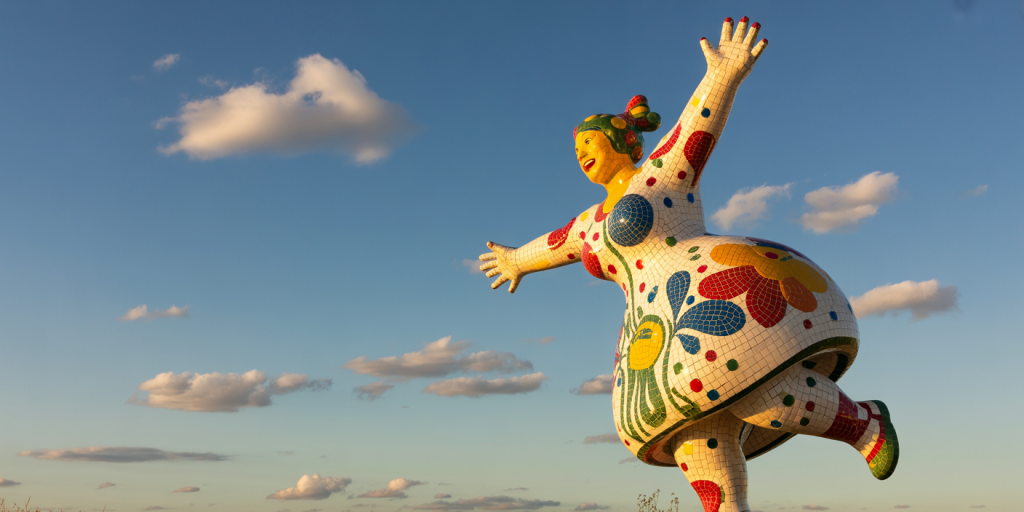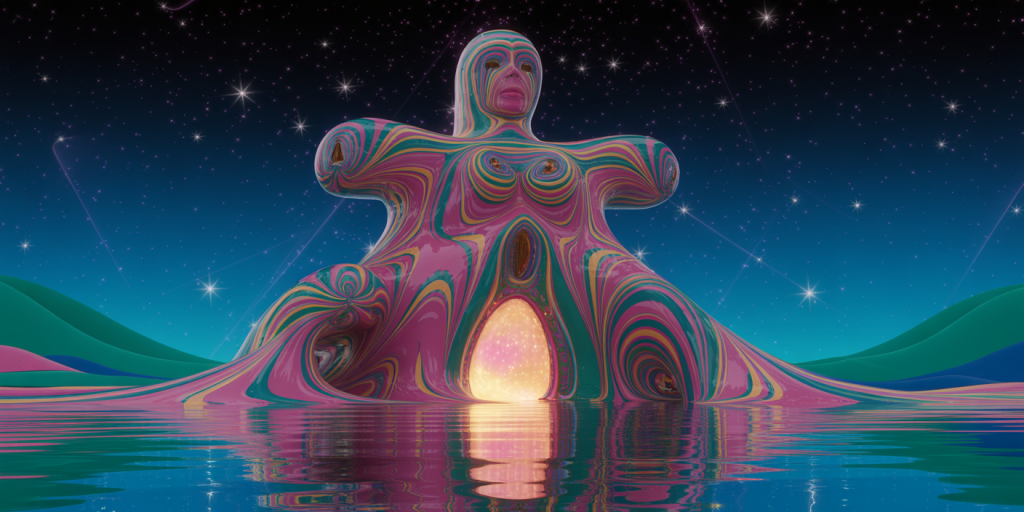Niki de Saint Phalle and Color as a Release from Weight
In the carnival of color where imagination blooms like wildflowers, one name splashes boldly against the gray: Niki de Saint Phalle. Her sculptures do not whisper; they sing, shout, erupt. They do not ask permission to exist. They demand joy. Like gardens sprouting from dreams, her works dance in mosaic brilliance, defying gravity not with physics but with spirit. There is no silence in a Niki sculpture. Only music, only laughter, only the thunderous echo of a woman refusing to be still.
Her world is not merely inhabited by forms—it is drenched in pulse and myth. We enter it not as spectators but as children running through a playground painted by liberation. The colors, the curves, the unapologetic presence of femininity become a symphony of defiance. Niki de Saint Phalle wielded color not as decoration but as incantation. Through it, she exorcised fear, trauma, repression. Through it, she flew.
Table of Contents
- The Blossoming of a Fury
- Rainbows as Resistance
- The Garden of Bullets and Bloom
- Monumentality as Woman
- The Dance of the Nanas
- Mosaic Skin, Mosaic Soul
- Explosions in Paint and Flesh
- Tarot as Architecture of Freedom
- Feminine Forms, Cosmic Shapes
- Playgrounds of Power
- Suffering Transfigured in Color
- Echoes of Gaudi, Dreams of Eve
- Healing Through Glass and Stone
- Smiles in the Face of Scars
- The Architecture of Emotion
- Technicolor Rebellion
- The Texture of Joy
- Bodies that Laugh
- The Divine Made Visible
- Notes from the Edge of Delight
The Blossoming of a Fury
Niki’s early years were haunted by violation and silence. From that soil of trauma bloomed a fury too vibrant for words, a fury she transformed into pigment, plaster, and mythic shape. In her works, color is not aesthetic choice; it is reclamation. Each hue pulses with a defiant heartbeat. Her reds are not red. They are screams. Her blues, bottomless memories. Her yellows, laughter cracking through restraint.
Her materials were often humble—papier-mâché, chicken wire, found objects—yet their presence roared like temples. It is in that contradiction, between fragility and monumentality, that her genius sings. Saint Phalle’s sculptures are not merely large. They are enormous with intention.
Rainbows as Resistance
For Niki, the spectrum of color became a vocabulary of freedom. In a world carved by binaries—male/female, beauty/grotesque, sacred/profane—she painted with the entire rainbow, resisting categorization. Her palette was never passive. It radiated an almost chromatic scream, a celebration and indictment all at once.
Every mosaic shard glitters like a shard of consciousness. Her colors seem to sweat with life, sometimes joyful, sometimes ominous. They resist the grayscale of societal conformity. Her rainbows were not decoration. They were flags flown in revolt.
The Garden of Bullets and Bloom
Saint Phalle’s Shooting Paintings (Tirs) marked her first aesthetic rebellion. With a rifle, she shot bags of paint hidden beneath layers of plaster. Each explosion became a flower, a burst of truth erupting through the surface. Creation through destruction. Violence rendered sacred. It was the inverse of war: bullets used not to kill but to uncover hidden beauty.
Color poured from wounds she inflicted herself—a ritual of catharsis. In these works, the body is both the canvas and the battlefield. The resulting splashes and drips are ungoverned, yet profoundly intentional. They are not accidents; they are exorcisms.
Monumentality as Woman
When Niki turned to sculpture, her figures grew colossal. Not to imitate masculinity, but to shatter its monopoly on monumentality. Her women—round, dancing, laughing—took up space with unapologetic joy. The famous Nanas were not delicate maidens but mythic matriarchs: goddesses of glee, painted in neon.
Each Nana radiates a gravitational pull. They are not static; they move, mid-dance, hips swirling with the universe. They carry the weight of history and joy, and yet appear to float. Their boldness is their liberation. Their size, a feminist manifesto.
The Dance of the Nanas
The Nanas prance like joy incarnate. Painted in eye-searing hues and polka-dotted dreams, they cavort in absurdity and freedom. One might wear a bathing suit made of stars. Another might be caught mid-kick, her skirt a sunburst. They celebrate bodies as they are: soft, round, powerful.
They reject shame, shrug off expectation. They do not pose; they play. Their limbs stretch into possibility. Their bellies are sanctuaries. Their breasts are beacons. They are the goddesses we forgot we needed.

Mosaic Skin, Mosaic Soul
There is something alchemical in how Niki assembles her surfaces. Mirrors, tiles, glass—all shards once broken, now reborn. As if her sculptures wear the very fabric of time. Each reflective piece catches the world, fragmenting it into kaleidoscopic wonder. You do not look at her work. You see yourself inside it.
The mosaic becomes both texture and metaphor: the self is fractured, then whole. Pain, once shattered, is reassembled in radiance. Saint Phalle’s art is skin that gleams with remembered light.
Explosions in Paint and Flesh
Saint Phalle’s process was intensely physical. She climbed, hammered, painted, poured. Her body was part of the medium. Her voice, urgent. She once said, “Shooting made me feel wonderful, free, relieved.” In this, her creations are not only seen but lived.
Color exploded from the womb of her gesture. She performed art as ritual, summoning not just aesthetics but healing. One sees it in the erratic drips, the anarchic splashes—beauty born from movement, not control. She made the canvas bleed to let herself breathe.
Tarot as Architecture of Freedom
In her magnum opus, the Tarot Garden in Tuscany, Niki erected life-sized cards of the Major Arcana. The Empress becomes a habitable womb, the High Priestess, a tower of mirrored wisdom. Visitors walk within myth. She transformed symbols of fate into shrines of choice.
Here, architecture dances. The Tarot cards are not flat images but volumetric dreams. Color is not surface—it is skin, mood, meaning. Her garden is a place of pilgrimage. Not to escape reality, but to reimagine it.
Feminine Forms, Cosmic Shapes
The curves of her sculptures echo planets, galaxies, fertility statues. Her use of shape ties the feminine to the universal. Breasts are suns. Hips are moons. Her works suggest the body as cosmos, its orbits sacred, its tides unstoppable.
This cosmic connection liberates the female form from erotic objectification and restores it to divinity. In Niki’s universe, femininity is not marginal. It is celestial.
Playgrounds of Power
Unlike traditional sculpture gardens, Niki’s environments invite touch, laughter, interaction. She envisioned spaces where adults could play again, without guilt or restriction. Art becomes participatory. Joy becomes a political act.
Children climb her monsters. Lovers kiss inside her temples. Each piece becomes a playground of power—a reminder that freedom is not only fought for, but also celebrated.
Suffering Transfigured in Color
Her works do not deny suffering. They transform it. Through riotous color, trauma is reimagined. Her own history of abuse and mental anguish becomes kaleidoscopic. Darkness is not hidden but recast in light.
There is something sacred in this. As if each sculpture is a reliquary of pain turned to gold. A laughter that rises from ash.
Echoes of Gaudi, Dreams of Eve
Saint Phalle was deeply inspired by Gaudí, and one sees his influence in her playful mosaics and architectural exuberance. Yet her vision is more subversively mythic. While Gaudí built for God, Niki built for goddess.
Her gardens are modern Edens, peopled by radiant Eves who bite into joy and refuse exile. They are creation myths for the future, spun in tile and glass.
Healing Through Glass and Stone
The tactile surfaces of her work are themselves therapeutic. Smooth mirrors, rough pebbles, ceramic warmth—textures that ground the viewer in the present. Her art invites caress. It speaks in touch.
There is a psychology to it: trauma lodges in the body, and healing begins in the senses. Her spaces act like sanctuaries. You leave them lighter than you entered.
Smiles in the Face of Scars
Saint Phalle does not erase pain; she meets it with a grin. Her sculptures beam like survivors, their joy hard-won. Behind every bold curve is a history. Behind every sparkle, a storm.
And yet they dance. They sing. Their survival is their splendor. They do not ask for pity. They offer communion.
The Architecture of Emotion
More than buildings or objects, her large-scale works are habitats of feeling. You walk through anger, through ecstasy, through wonder. Each arch, each hollow, is like a chamber of the heart.
There is no sterile distance. The viewer is implicated, embraced. Art, here, is not aloof. It is intimate, architectural emotion made stone.

Technicolor Rebellion
Color, in Saint Phalle’s hands, becomes a revolutionary act. Her hues scream against erasure. They assert presence. In an art world once dominated by gray abstraction, she dared to be loud, to be seen.
Her palette is neon prophecy. It speaks of a world possible beyond patriarchal dullness. A world lush with expression. A world on fire with joy.
The Texture of Joy
Joy, in her work, is not naive. It is sculpted. It has weight, depth, and complexity. It is built shard by shard. Her textures are layered with story. Smoothed by hope, pocked by grief, encrusted with resistance.
Each surface reads like a diary written in stone. We run our fingers over survival itself.
Bodies that Laugh
Her figures laugh. Not politely. Not behind hands. They howl. Their laughter is body-deep, womb-rooted. It shakes the air around them. It embarrasses solemnity.
And this, too, is radical: a woman laughing without permission. A body rejoicing in itself. In Niki’s work, joy becomes weaponized.
The Divine Made Visible
Saint Phalle renders the divine in mosaic flesh. Her works are temples of color, shrines to the sacred everyday. Her goddesses do not float above. They walk, dance, cry, sing.
In her hands, spirituality is not abstraction. It is embodiment. The sacred is sculpted, sensual, here.

Notes from the Edge of Delight
To witness Niki de Saint Phalle’s art is to encounter delight sharpened into clarity. It is to remember that joy can be deliberate. That play is sacred. That color, when wielded boldly, can free not just the eye, but the soul.
Her works do not fit into categories. They burst through them. They are too alive, too urgent. They are not answers. They are invitations. To feel. To dance. To heal. To rage. To reclaim.
Frequently Asked Questions (FAQ)
Who was Niki de Saint Phalle? A French-American sculptor, painter, and filmmaker (1930–2002) known for her vibrant, monumental works, feminist themes, and use of unconventional materials.
What are the Nanas? A series of large, joyful, brightly colored female figures celebrating femininity, freedom, and body-positivity.
What is the Tarot Garden? A sculpture park in Tuscany, Italy, inspired by tarot cards, built by Niki over two decades and filled with walkable, livable sculptures.
What is the significance of mosaic in her work? It symbolizes healing, wholeness from fragmentation, and reflects light and the viewer, making each sculpture participatory.
How did trauma influence her art? Her work was a form of catharsis, transforming personal and social trauma into beauty, often through explosive or tactile techniques.
What artistic influences shaped her? Gaudí, Dubuffet, feminist theory, and spiritual symbolism all shaped her expressive, maximalist style.
Pontos de Luz na Tempestade
Niki de Saint Phalle teaches us that color is not just pigment. It is protest. It is prayer. It is possibility. She shows us that the feminine can be monumental, that pain can birth beauty, and that laughter is a form of flight.
Her art is not an escape from the world. It is an entrance into a brighter one.
